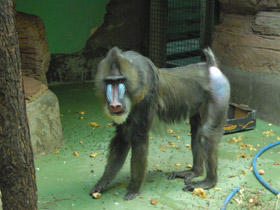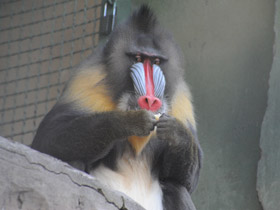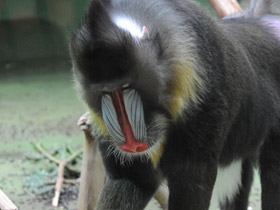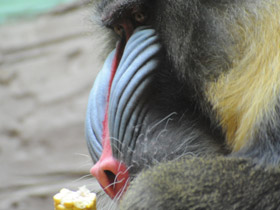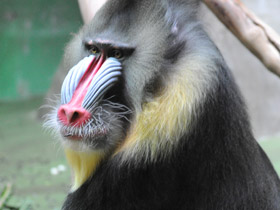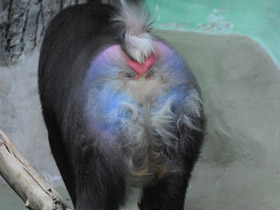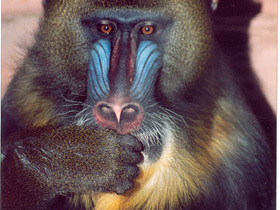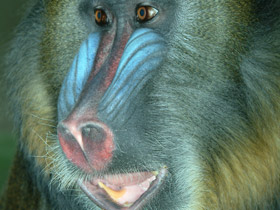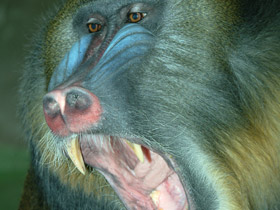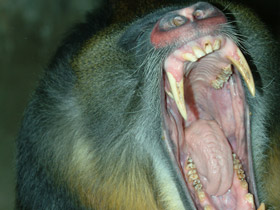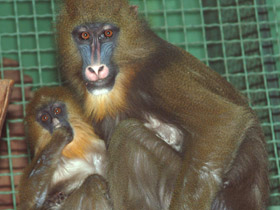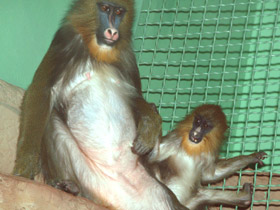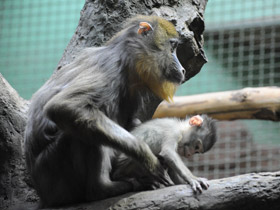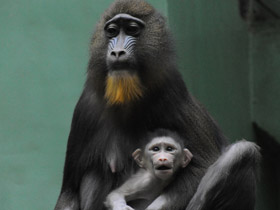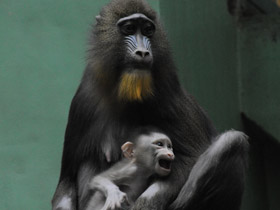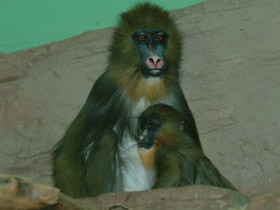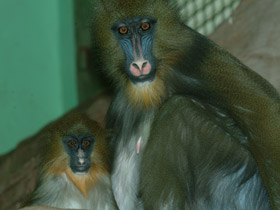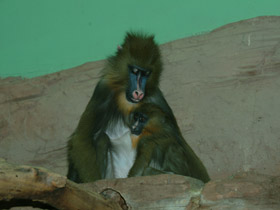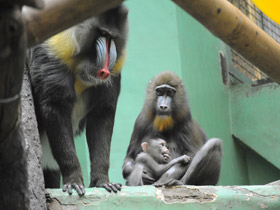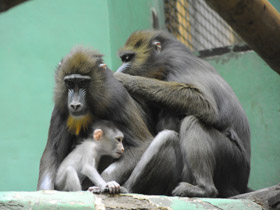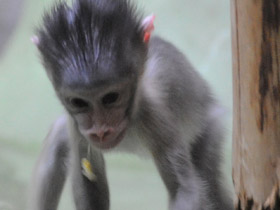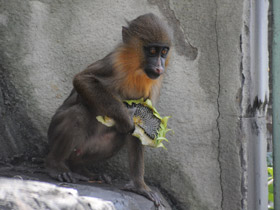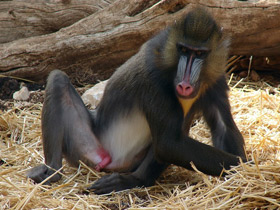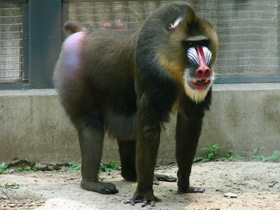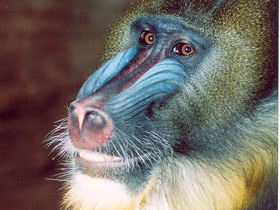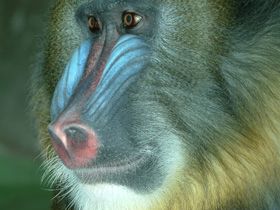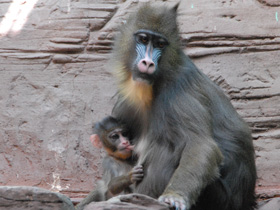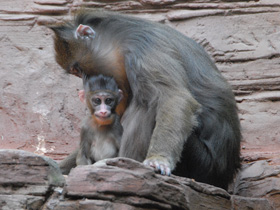The mandrill (Mandrillus sphinx)
 The mandrill (Mandrillus sphinx) is included in the IUCN Red List as a "vulnerable species"
The mandrill (Mandrillus sphinx) is included in the IUCN Red List as a "vulnerable species"
The mandrill (Mandrillus sphinx) is a large Old World monkey native to west central Africa. It is one of the most colorful mammals in the world, with red and blue skin on its face and posterior. The species is sexually dimorphic, as males have a larger body, longer canine teeth and brighter coloring. It is the largest monkey in the world. Its closest living relative is the drill, with which it shares the genus Mandrillus. Both species were traditionally thought to be baboons, but further evidence has shown that they are more closely related to white-eyelid mangabeys.
Mandrills mainly live in tropical rainforests but will also travel across savannas. They are active during the day and spend most of their time on the ground. Their preferred foods are fruit and seeds, but mandrills will consume leaves, piths, mushrooms, and animals from insects to juvenile antelope. Mandrills live in large, stable groups known as "hordes" which can number in the hundreds. Females form the core of these groups, while adult males are solitary and only reunite with the larger groups during the breeding season. Dominant males have the most vibrant colors and fattest flanks and rumps, and have the most success siring young.
The mandrill is classified as vulnerable on the IUCN Red List. Its biggest threats are habitat destruction and hunting for bushmeat. Gabon is considered the stronghold for the species. Its habitat has declined in Cameroon and Equatorial Guinea, while its range in the Republic of the Congo is limited.
Etymology
The word mandrill is derived from the English words man and drill—the latter meaning 'baboon' or 'ape' and being West African in origin—and dated to 1744. The name appears to have originally referred to chimpanzees. The first scholar to record the name for the colorful monkey was Georges-Louis Buffon in 1766. It was called the "tufted ape", "great baboon" and "ribbernosed baboon" by Thomas Pennant in A Synopsis of Quadrupeds (1771) and A History of Quadrupeds (1781).
Taxonomy
The mandrill was first scientifically depicted in Historia animalium (1551–1558) by Conrad Gessner, who considered it a kind of hyena. The species was formally classified by Carl Linnaeus as Simia sphinx in 1758. Its current generic name Mandrillus was coined by Ferdinand Ritgen in 1824.
Historically, some scientists placed the mandrill and the closely related drill (Mandrillus leucophaeus) in the baboon genus Papio. Morphological and genetic studies in the late 20th and early 21st centuries found a closer relationship to white-eyelid mangabeys of the genus Cercocebus. Some have even proposed that the mandrill and drill belong to Cercocebus. Two genetic studies in 2011 clarified Mandrillus and Cercocebus as separate sister lineages. The two genera split around 4.5 million years ago (mya) while the mandrill and drill split approximately 3.17 mya. Fossils of Mandrillus have not been found.
Some authorities have divided mandrill populations into subspecies: the northern mandrill (Mandrillus sphinx sphinx) and the southern mandrill (Mandrillus sphinx madarogaster). A proposed third subspecies, Mandrillus sphinx insularis, was based on the mistaken belief that mandrills are present on Bioko Island. The consensus is that mandrills belong to one subspecies (Mandrillus sphinx sphinx).
Cytochrome-b sequences suggest that mandrill populations north and south of the Ogooué River split 800,000 years ago and belong to distinct haplogroups. This divergence appears to have also led to the splitting of the mandrill strain of the simian immunodeficiency virus (SIV). The draft (incomplete) genome of the mandrill was published in 2020, with a reported genome size of 2.90 giga–base-pairs and high levels of heterozygosity.
Appearance
Mandrillus sphinx is a species of catarrhine primate of the family Cercopithecidae (Old World monkeys). It is related to baboons and more closely to the dril. The mandrill and the dril were once classified in the genus Papio, but later research led to their separation into a separate genus, Mandrillus. Mandrillus sphinx is one of the brightest and most unusually coloured monkeys. Its muzzle is covered on the sides of the nose with callosities on the cheeks, furrowed by deep folds.
At puberty (6-7 years), the callosities turn blue, the furrows and nostrils flame red, the sciatic callosities purple, the skin of the tail reddish purple and the beard bright red.
Habitat and nutrition
Mandrillus sphinx is the largest of the baboons, but unlike the savannah-dwelling anubis, it lives in the rainforest. Adult males hardly ever leave the ground, females and cubs climb trees to gather fruit, but they also spend most of their time on the ground. Here they collect fallen fruit, scavenge stones and fallen leaves for small invertebrates, gather nuts and seeds, and dig up tubers and rhizomes.
Social behaviour and reproduction
Mandrillus sphinx is very rare and is listed on the IUCN Red List. There is very little information on the forest life of these monkeys, but they are known to occur in groups of 10-15 animals led by an adult male. There are also multi-million groups of up to 200 individuals, which sometimes appear after small groups gather and disintegrate after a while. Pregnancy in the jaws lasts about 240 days and a single calf is born.
Threats and conservation
As of 2019, the IUCN Red List lists the mandrill as vulnerable. Its total population is unknown but is suspected to have decreased by more than 30 percent over the last 24 years. Its main threats are habitat destruction and hunting for bushmeat. The mandrill appears to have suffered massive habitat loss in Equatorial Guinea and southern Cameroon, while its range in the Republic of the Congo is limited and its status is unknown. In addition, while mandrills live in groups numbering in the hundreds, hunting in Cameroon and Equatorial Guinea appears to have led to smaller group sizes. Gabon is seen as the most important remaining refuge for the species, and the country's low population density and vast rainforests make it a good candidate for mandrill conservation. Surveys have shown high population numbers for other primate species like chimpanzees and gorillas. A semi-wild population exists at the International Centre of Medical Research of Franceville.
The mandrill is listed under Appendix I by CITES, banning commercial trade in wild-caught specimens, and under Class B by the African Convention, which provides them protection but allows special authorization for their killing, capturing or collecting. There is at least one protected area for mandrills within each of the countries they inhabit. In Gabon, most of the rainforests have been leased to timber companies but around 10 percent is part of a national parks system, 13 of which were established in 2002.

















